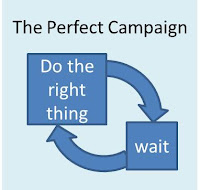I’ve long said that the best campaign design would be a simple circle: the system executes the best treatment for each customer, waits a day, and repeats the process. My point is that elaborate, branching flows are too complex for most marketers to build and maintain, and – because reality is infinitely messier than even the most sophisticated flow chart – will often give customers a sub-optimal treatment.
It’s probably just as well that no vendor has ever built a system based on my design. But the good folks at Marketo have taken a step in that direction with their latest enhancement, which they call an “engagement program”. It has more than one step but does get away from the idea of a rigid, branching campaign flow. Instead, it is organized in terms of “streams” that contain pools of content. Once a customer is added to a stream, the system will offer the next piece of content whenever a contact is due according to the campaign cadence. What’s next is set by the order of content within the stream: users just drag content into the container and put on top the ones they want sent first. The system will go through the content in this order during each execution (which Marketo calls a “cast”), and send each person the first item they have not already received. This avoids duplicate messages and lets the system deliver a defined series of messages without explicitly setting up a sequence. It also makes it almost effortless to insert a high priority message that goes to everyone or to swap out contents as new materials become available.
As you’ll immediately notice, sending the next thing isn’t quite the same as sending the best next thing. In my ideal world, the content would be selected by calculating the value of each item for each individual and taking the highest. This would only take a small tweak in the current approach, which is one reason I like what Marketo has done. Marketo does in fact plan to apply predictive modeling to the system, although I think they’re trying to find the most effective content sequence for all customers, rather than scoring content at the individual level.
There’s quite a bit more to the new Marketo feature than I’ve described so far. Content can actually be a multi-step program of its own, such as a sequence of messages to promote and manage a Webinar. Content can also have availability dates that are enforced automatically, so future messages can be added at any time and obsolete messages are automatically discontinued. One thing that’s missing is eligibility rules on content, to let users specify who is allowed to receive it. This is a key feature in traditional decision management systems, permitting customer-level customization within a fixed priority sequence. But Marketo users can achieve the same thing by embedding content within programs, which do have such rules, and adding the programs to the stream instead of the content itself. This is Marketo’s recommended approach because it also provides better data for reporting.
Users can further tailor treatments to customers by setting up multiple streams within one engagement program. Each stream has “transition rules” that pull in qualified customers from other streams. This is less rigid than having selection rules in one stream push customers to another stream. It’s not quite clear what happens if someone qualifies for more than one stream: Marketo’s position is that would only happen if you make a mistake. I think reality is not so tidy. Marketo is considering letting marketers prioritize the transitions based on the position of the streams, just as they prioritize contents within a stream.
In any event, customers can only be in one stream at a time, so they won’t receive multiple messages from the same engagement program. Whether they receive messages from multiple programs is controlled by Marketo’s standard communication limit features, which can set a maximum number of messages per day and per week. Users can decide whether those limits apply to any particular program. The system also lets salespeople or other programs pause messages from an engagement program to an individual customer.
The new package includes a good set of reports that track content usage and results. They also provide an “engagement score” that combines several success metrics into a single value. Other reports show how many people in the program have run out of content – a good way to ensure the company doesn’t lose touch with them. Surprisingly, there’s no report on movement from one stream to the next. But Marketo says this can be set up using their revenue performance management module, which tracks movement of customers across other types of stages.
The engagement engine is included in all Marketo versions, although lower-level versions have some limits. Adding a more powerful version to the Standard edition of Marketo starts at $295 per month.






